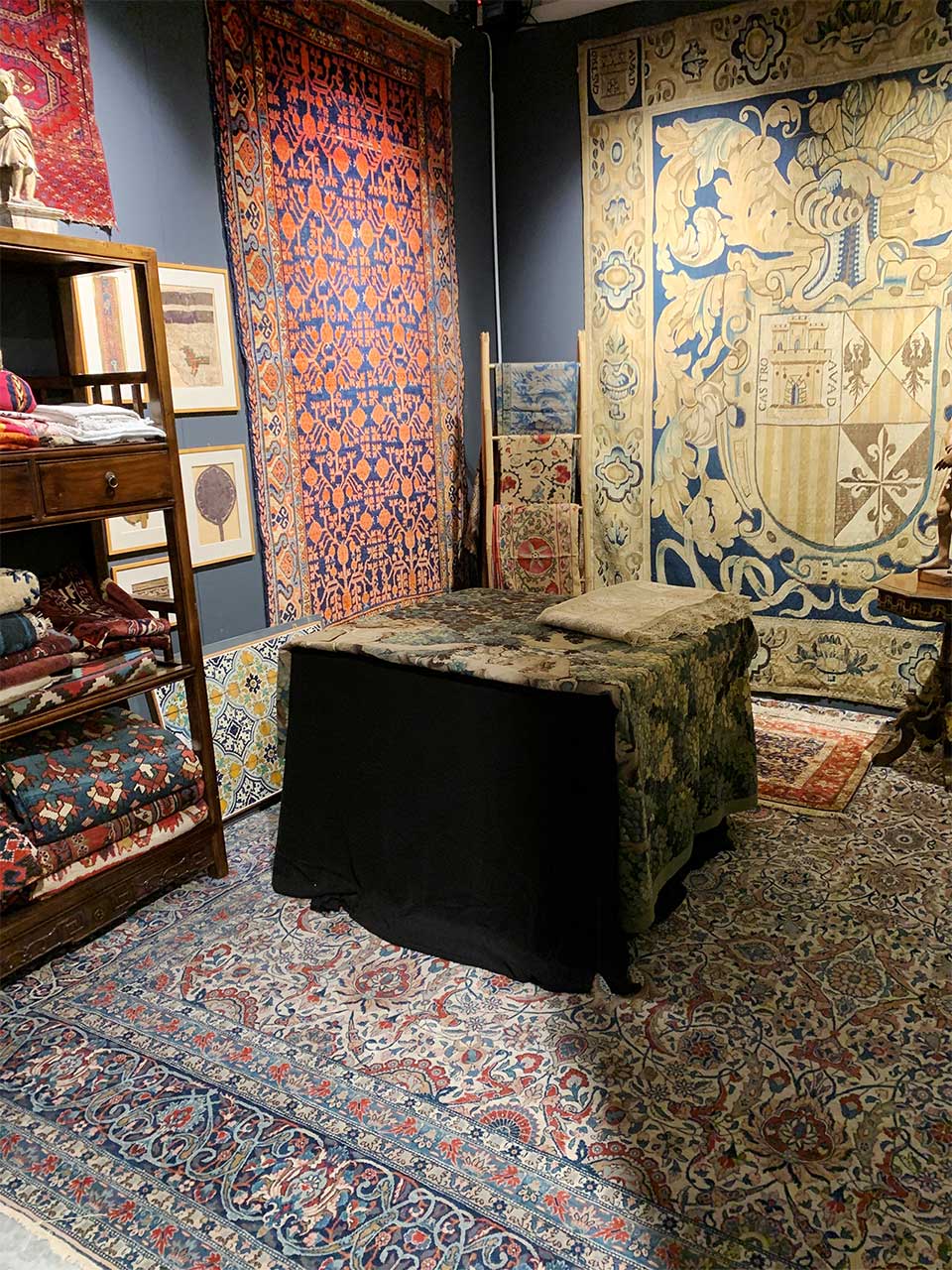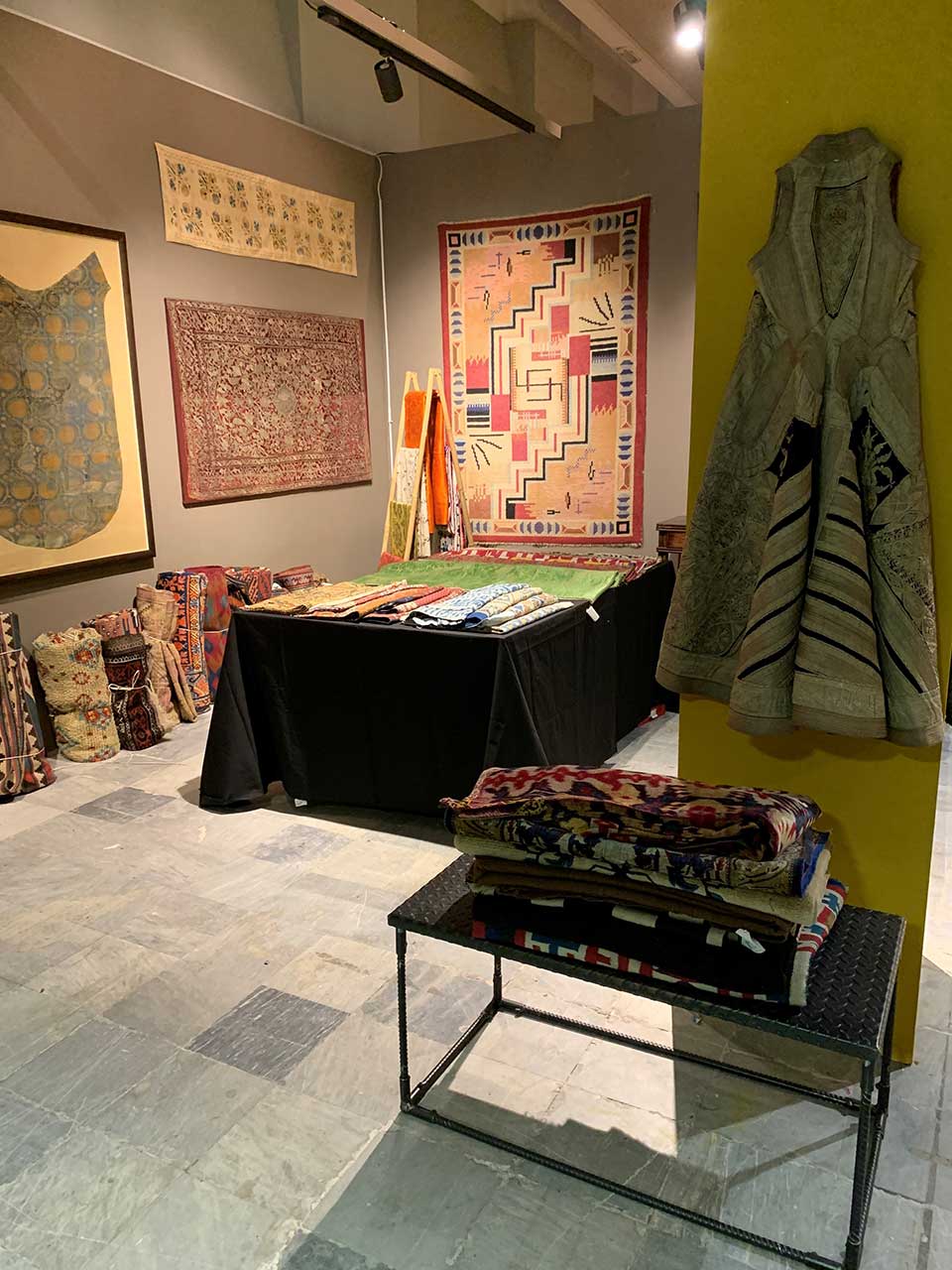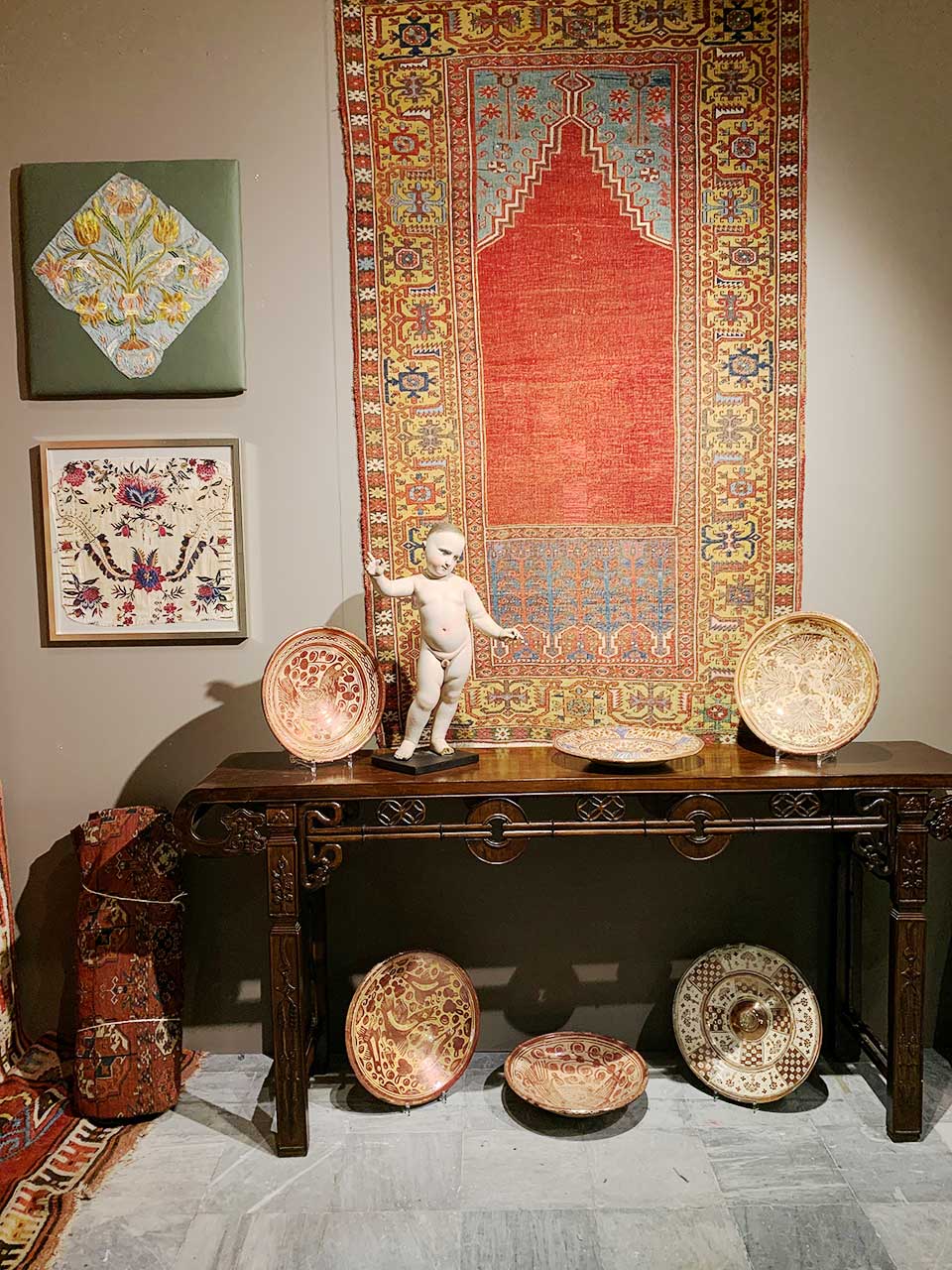What made these pieces so fascinating for me?
Unlike today´s rug production the weavers in the past were not subservient to whatever trend in decorating is currently en vogue. At present, floor covering is all about colour and pattern, is mostly mass produced and not meant to last long. The case for the antique carpet could be a sad one if there were not groups of people, collectors, but also people with a good eye, who cherish what antique rugs have to offer. Collectors savour the past ways of life and tradition expressed in those old pieces, which open doors to long gone times and former social systems.
Stock antique rugs
Tekke Juval
ID: 16746
Age: Early 19th century
Origin: Turkmenistan Tekke tribe
Size: 80 cm x 120 cm
Info: a beautiful early piece with a lot of presence an deep glowing colours. Small kinks.
Afshar
ID: 16805
Age: Around 1900
Origin: Persia
Size: 179 x 134 cm
Info: a beautiful decorative Afshar rug, in perfect condition wit chunky wool.
Gafsa Oasis Kilim Fragment
ID: 16643
Age: ca. 1850
Origin: Tunesia
Size: 122 cm x 182 cm
Info: a rare and striking tribal weaving. Charasteristic for the Gafsa design pool is the combination of abstract renderings of camels and checkerboard quadrants. The colours are especially vibrant.
Condition: some damage in parts, which have been backed. A true collector’s piece.
Belouch
ID:
Age: late 19.century
Origin: Persia
Size: 0,87 x 1,62 m
Info: this is a very nice old rug with an interesting version of a mina khani pattern. It shows a lot of aubergine wool which is a sign of good age.
Shasavan Kilim Panel
ID: 16732
Age: Late 19th century
Origin: Persia
Size: 105 cm x 183 cm
Info: good strong colours and very good condition. Taken from a complete Mafrash bag.
Belouch
ID:
Age:
Origin: Afghanistan
Size: 1,04 x 2,02 m
Info: the oldest and most desired mina khani rugs show white flowers with 5 petals. Ours has 6 petals, indicative of a later date. But it is still a nice thing.
Swedish rya rug
ID:
Age: the rug says 1928
Origin: Sweden
Size: 1,52 x 2,45 m
Info: these ryas are loop-piled, which makes them soft and pliable, they are cuddly rugs.
Talish
ID:
Age: mid 19 century
Origin: The Caucasus
Size: 1,07 x 2,87 m
Info: a very rare Talish rug, with the typical border design, but a very unusual center of botehs. It has happy Caucasian colours and the condition is fair.
Balouch in a rare design
ID:
Age: ca. 1900
Origin: Persia
Size: 0,99 x 1,80 m
Info: a finely woven early Balouch with a rare design. Nice electric blue.
Arab Balouch
ID:
Age: late 19century
Origin: Afghanistan
Size: 0,99 x 1,90 m
Info: a very interesting rug! It feels very tribal in its handle and is of sombre beauty. In its field corroded black wool has goven the zigzag design a sculpted depth.
Lori Pambak Kazak
ID: 16443
Age: Second half 19th century (1850 – 1899)
Origin: Fachralo, Kazak, Central Caucasus
Size: 154 cm x 125 cm
Info: very good in good pile except for a couple of narrow bands of corrosive dye (visible in details). A star Kazak! Uncommon design. Nice, square, dimunitive size. Rare.
Balouch Balisht
ID: 16736
Age: Late 19th century
Origin: Afghanistan
Size: 50 cm x 95 cm
Info: this small piece has a very tribal feel with its chunky wool and the tree of life pattern in a very abstract rendition. Good condition
Tibetan rug
ID:
Age: late 20 century
Origin: Nepal
Size: 0,92 x 2,10 m
Info: excellent condition, great wool, attractive colours.
khotan rug
ID:
Age: ca 1900
Origin: khotan area, silk road
Size: 1,37 x 2,66 m
Info: the rug has a classical pomegranate design, the joyful red is a chemical dye.
small Kirman rug
ID:
Age: ca. 1900
Origin: Persia
Size: 0,63 x 0,77 m
Info: a lettle jewel! Finely woven, natural dyes. A perfect fit for a grandfather chair.
Kurdish kelleh
ID:
Age: late 19 century
Origin: Persia
Size: 1,50 x 3,15 m
Info: a large Kurdish rug with a nice, typical crab border.
Kazak
ID: 16817
Age: late 19th century
Origin: The Caucasus, Russia
Size: 274 x 134 cm
Info: a good-sized Kazak in all natural dyes with large medaillons and an expressive, wide crab border. Good condition, some repairs.
Belouch
ID:
Age: early 20 century
Origin: Arab tribe
Size: 1,07 x 2,00 m
Info: a powerful example of this well known type. The design is bold, the weave chunky.
Ghördes prayer rug
ID:
Age: ca. 1800
Origin: West Turkey
Size: 1,12 x 1,70 m
Info: a very attractive antique prayer rug in muted colours. Green is said to be the colour of the prophet. No restauration in the center.
gashgai
ID:
Age: late 19 century
Origin: Persia
Size: 1,34 x 1,86 m
Info: very typical for a South Persian tribal rug in size, colours and design.
Small Ninghsia Runner
ID: 16739
Age: Late 18th century
Origin: China
Size: 60 cm x 110 cm
Info: an elegant rug with classical design, sadly some wear
chinese-mat
ID:
Age: ca. 1800
Origin: China
Size: 0,58 x 0,84
Info: sadly, the ends of this charming Chinese mat are missing.
Ersari
ID:
Age: ca. 1900
Origin: Central Asia
Size: 1,15 x 2,00 m
Info: a very attractive, white ground Ersari rug with an abstract boteh pattern design. The remnants of the original kilim ends are still on each end.
Genje rug
ID:
Age:
Origin: The Caucasus
Size: 1,48 x 2,36 m
Info: this is a very pleasant decorative Caucasian rug in good size. The all over pattern on blue sky is typical of the Genje area.
Belouch prayer rug
ID:
Age: ca. 1900
Origin: Jamshidi tribe
Size: 0,94 x 1,38 m
Info: the nice Feature about this rug is thatnit still has both its kilim ends.
In the 19th century rug weaving had become increasinglyorganized in large manufactures, often run by Western businesses.Previously, weaving was done by tribal women.the men of the tribe raised the sheep, and, once the wool was washed, women took over the next steps: carding, spinning, dyeing and weaving the wool. the rug patterns were traditional and remained similar for generations. A woman expressed who she was, which family of origin hers had been and which tribe she had married into by small variations of the traditional patterns of her tribe.
Dowry pieces were made with pride and were often family heirlooms
The weavers´lives were hard in the hot and dry climates of Asia. Dusty brown was the dominant colour in the summer months. the vibrant rugs these women wove made a world of beauty and colour accessiblethat did not exist outside the tent. This tribal way of life has disappeared forever. Modern Westerners need to get accustomed to the visual language of rugs. We need to take time to look closely in order to see differences in quality. We need to compare naturally dyed rugs with chemically dyed ones. We need to develop a sensitivity for fine shades in colour. Chemically dyed wool refracts the light in a different way than naturally dyed wool does, the latter produces finely varied tones within one skein of wool, the former produces uniformly coloured wool.
The museums of the world show rugs in the context of their culture of origin. They have become acknowledged as pieces of art, as well as tributes to the history of the world´s ethnic societies. I have long been in awe of these older tribal sisters, their creativity and stamina. I feel kinship and increasing respect for their art and their guts. And because images speak louder than words, here are three images of how we present our antique rugs at fairs:
Image 1: this is how we looked at the fair in Torino, Italy, autumn 2020. We carry unusual piecesa like the big Spanish tapestry at the back of the wall, the red pomegranate Khotan on the left hand wall or the large ivory ground Ghazwin carpet on the floor. Image 2: this is how we looked before,in 2019, also in Torino. There is a rare German Bauhaus rug on the back wall amongst textiles. Image 3: the rug on the wall, a rare Ladik of the 18.century.

We are an international gallery that exhibits regularly in London and the USA. Our warehouse focuses on antique textiles, antique rugs, European and Asian sculptures, ceramics and other artifacts.





